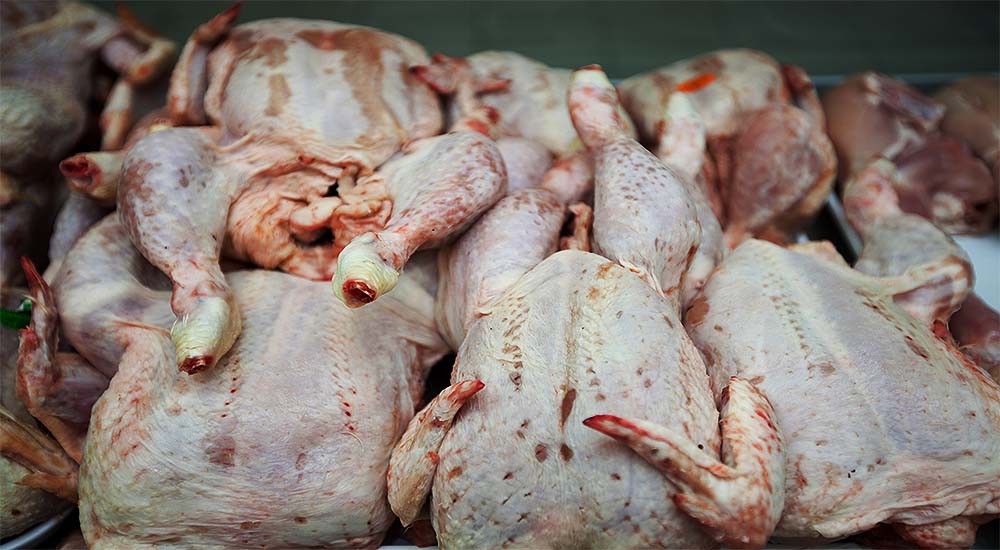Why Chicken was tainted with Arsenic since 1944

Commercial chickens are unhealthy
Chickens get a variety of infections. To give chicken meat a nice pink color and kill infection, arsenic laden drugs have been added to chicken feed for over 72 years.
Arsenic was used during the Victorian era in cosmetics. Popular skin products contained strong doses of arsenic because it lent a delicate pink “blush” to the complexion. The unhealthy practice continued despite its known risks – Ah, the price of vanity!
Arsenic-containing drugs killed infections, but at what risk?
Drugs containing arsenic were given to chickens in their feed for over seven decades. The chicken industry always assured the American people that it was safe, insisting they were using the non-dangerous, organic, form of arsenic.
The drug company, a division of Pfizer, stated that only safe organic arsenic was used and that it would be excreted without harming the birds, or humans who ate their meat.
[Note: organic arsenic is not dangerous, inorganic arsenic is a known carcinogen.]
The drug company was wrong. Cooking chicken is one mechanism by which safe organic arsenic is transformed into the cancer-causing inorganic arsenic.
In 2011 researchers discovered high levels of dangerous arsenic in the livers of chickens, making it clear that the practice of using these drugs was dangerous for human health.
Scientists confirm the link between arsenic and cancer
A report from Chemical & Engineering News revealed that under certain anaerobic conditions, within live birds as well as on farmland, the organic arsenic morphed into the toxic arsenic. The scientists were quoted as saying:
“Arsenic has been linked to bladder, lung, skin, kidney, and colon cancer, while low-level exposures can lead to partial paralysis and diabetes.”
FDA admits there’s no safe level of arsenic
You can read early reports from the FDA stating that only very small amounts of inorganic [cancer-causing] arsenic are found in the meat of chicken. “Small amounts” doesn’t sound too bad, right? Wrong!
It took until 2015 for the FDA to admit that 70% of the chicken purchased in the U.S. contained dangerous arsenic levels, above their safety “threshold” level. Later they admitted there was actually no “safe” amount of arsenic – the threshold is actually zero.
As mentioned above, arsenic is known to cause a variety of cancers in humans, along with diabetes and heart disease.
When I published Part 1 of my blog on Arsenic and Rice a smart patient if I was discussing safe organic or inorganic arsenic, a known Class 1 carcinogen.
Unfortunately, it is the latter; rice does indeed contain the inorganic, cancer-causing arsenic, as does chicken.
Why would our government allow arsenic in chicken?
The thought that our Food and Drug Administration (FDA) watches out for us and keeps us safe and protected, is sadly naïve and gullible. I hate to say it, but the FDA knows they’re putting us at risk; they know yet they do nothing to change the toxicity level of our food until they are forced to.
Let’s look at a little recent history for proof. In 2009 the ‘‘Poison-Free Poultry Act of 2009’’ was brought before Congress. We know it was unsuccessful because in 2011 it was again presented, just renamed the ‘‘Poison-Free Poultry Act of 2011”. Congress again did nothing.
Two years later, 2013, the FDA was sued by a coalition of nine groups. They won, and two years later, the end of 2015, the arsenic-containing chicken drugs were removed from the market. A battle that began in 2009, came to a successful conclusion in 2016, thanks to a gutsy group who banded together to sue the FDA. Not an easy task.
Approved in 1944, the drug Roxarsone, tainted our chickens with arsenic for 72 years. It is now off American shelves but, unfortunately, it continues to be exported and utilized in at least ten other countries worldwide, some of which we use to import chicken back into the U.S. Really?!
What are we using now to ensure chickens aren’t sick?
Drugs are still used on chickens, they just aren’t the ones that contain arsenic. But drugs are still used because commercially raised chickens have many infections.
Will the new chicken drugs be a similar story to BPA? Remember when the chemical in hard plastic bottles was removed from plastic only to be replaced with BPS? We were told BPS was safe, but it’s apparently worse than BPA. It’s considered to be a more dangerous cancer-causing chemical than its predecessor.
Will the new chicken drugs be dangerous in a way we don’t yet know about?
Are you safe if you don’t eat chicken?
If you haven’t been a chicken consumer, you might consider yourself safe. Unfortunately, chicken poop (manure) contained arsenic and that manure made its way into our soil and water supply. Arsenic tainted chicken manure is one of the ways rice plants became toxic with arsenic. (For more on arsenic and rice, read: Is Arsenic in Rice a Real Problem, Part 1 and Part 2.).
The chicken industry has dumped two million pounds of manure into our environment each year – two million pounds! That’s a lot of toxic manure and it remains in our environment for years…
Will eating organic keep you safe? Yes and No.
Organic chickens are immune to this problem since they don’t receive drugs, but the arsenic that has permeated deep into our soil and water causes even organic rice and organic brown rice syrup to be no safer than its non-organic alternative.
Mushrooms are similar to rice and like to absorb arsenic from the land they are grown upon. Cultivated mushrooms are safer than the wild variety because their growing conditions can be controlled. If you’re a mushroom lover like me, this is good news.
When eating wild mushrooms, ensure they don’t grow near heavy industrial areas where toxins such as arsenic are prevalent in the soil.
Organic chickens, once again, are safe from this arsenic exposure, but my next blog(s) will review other aspects of chicken that even organic chicken is not immune to.
Stay tuned for future blogs on chicken
If you love chicken, you’ll want to learn more about it, especially if you want to improve your health. Upcoming blogs include data on:
- Is chicken making you gain weight? Do chickens have an obesity virus – one they can share with you?
- Chicken with a side of chicken poop; can you get one without the other?
- Salmonella with your chicken? How about E. coli?
- Does chicken raise your bad cholesterol?
Do you need help with your health?
We have the diagnostic and testing tools, the clinical experience, and a different medical approach to discovering the root cause of why you have the symptoms that are bothering you. As long as you are ready to make some dietary and lifestyle changes, we can help you. We will "hold your hand" through the changes, step by step, to make each step an easy one. We are located in Clearwater, FL, at 1000 S Ft Harrison, at the corner of Ft. Harrison Ave. and Magnolia St. There is plenty of parking space directly accessible from Ft Harrison. If it is not convenient for you to come to Root Cause Medical Clinic, we offer telehealth/telemedicine consultations to residents of certain states. Call us for details.
Contact us for a Consultation – Call 727-335-0400

Dr. Vikki Petersen DC. CCN
Founder of Root Cause Medical Clinic
Certified Functional Medicine Practitioner
Dr Vikki Petersen is a public speaker, author of two books, several eBooks and creates cutting edge content for her YouTube community. Dr Vikki is committed to bringing Root Cause Medicine and its unique approach to restoring health naturally to the world.
Ask a Doctor
Have a health concern you'd like to speak with a doctor about? Or just want clarity on a subject? Ask Us!
Featured Articles
Popular Stories
References:
- M. Mleczek, et al. Importance of low substrate arsenic content in mushroom cultivation and safety of final food product. European Food Research and Technology. March 2016, Volume 242, Issue 3, pp 355–362.
- Nearing MM et al. Arsenic speciation in edible mushrooms. Environmental Science and Technology. 2014 Dec 16;48(24):14203-10.
- Vogt R, et al. Cancer and non-cancer health effects from food contaminant exposures for children and adults in California: a risk assessment. Environmental Health. 2012 Nov 9;11:83.
- Marcason W. What are the current findings concerning arsenic in foods? Journal of the Academy for Nutrition and Dietetics. 2015 Jun;115(6):1028.
- Lasky T. Arsenic in chicken: a tale of data and policy. Journal of Epidemiology and Community Health. 2017 Jan;71(1):1-3.
- Schmidt CW. Arsenical association: inorganic arsenic may accumulate in the meat of treated chickens. Environmental Health Perspectives. 2013 Jul;121(7): A226.
- Aitken SL, et al. Agricultural Applications for Antimicrobials. A Danger to Human Health: An Official Position Statement of the Society of Infectious Diseases Pharmacists. Pharmacotherapy. 2016 Apr;36(4):422-32.
- Cordova C, et al. Playing Chicken with Antibiotics: Previously Undisclosed FDA Documents Show Antibiotic Feed Additives Don’t Meet the Agency’s Own Safety Standards. NRDC January 27, 2014,
- Lasky T, et al. Mean total arsenic concentrations in chicken 1989-2000 and estimated exposures for consumers of chicken. Environmental Health Perspectives. 2004 Jan;112(1):18-21.
- Rep. Israel, Steve [D-NY] Introduced 9/2009). To amend the Federal Food, Drug, and Cosmetic Act to ban the use of the arsenic compound known as roxarsone as a food additive. H.R.3624 — 111th Congress (2009-2010).
- Wallinga D. Playing Chicken Avoiding Arsenic in Your Meat. The Institute for Agriculture and Trade Policy. April 2006.
- Nachman KE, et al. Roxarsone, inorganic arsenic, and other arsenic species in chicken: a U.S.-based market basket sample. Environmental Health Perspectives. 2013 Jul;121(7):818-24.


